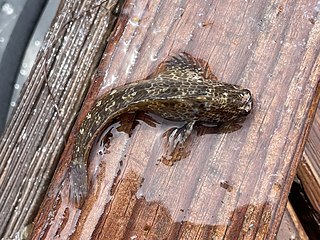
The molly miller is a species of marine ray-finned fish belonging to the family Blenniidae, the combtooth blennies. This species is found in the Atlantic, Mediterranean, and northwest Pacific Oceans. Its colour is a mottled tan, white, and black covering the body and fins. The head of this fish is covered with short hair-like appendages and has two very large eyes. This species reaches 12 cm (4.7 in) in total length.
Chasmodes saburrae, the Florida blenny, is a species of combtooth blenny found in the western central Atlantic Ocean, around the coast of the United States.

Hypleurochilus geminatus, the crested blenny, is a species of combtooth blenny found in the western Atlantic ocean. This species grows to a length of 10 centimetres (3.9 in) TL.
Hypleurochilus multifilis, the featherduster blenny, is a species of combtooth blenny found in the western Atlantic ocean, in the Gulf of Mexico around Texas, USA. Its distribution extends from central Florida to Tabasco, Mexico.
Hypleurochilus pseudoaequipinnis is a species of combtooth blenny found in the Atlantic ocean, in the Americas it ranges from Cape Canaveral, Florida to Santa Catarina in Brazil and the eastern Atlantic it is found off Sao Tome and Principe in the Gulf of Guinea.

Hypsoblennius is a genus of combtooth blennies found in the Pacific and Atlantic Oceans.

Hypsoblennius brevipinnis, commonly known as the barnaclebill blenny, is a species of combtooth blenny found on coral reefs in the eastern-central Pacific Ocean. This species grows to a length of 12 centimetres (4.7 in) TL.

Hypsoblennius caulopus, the tidepool blenny, is a species of combtooth blenny found among rocky reefs of the eastern Pacific ocean. This species grows to a length of 9 centimetres (3.5 in) TL.

Hypsoblennius gentilis, commonly known as the bay blenny, is a species of combtooth blenny found in the eastern-central Pacific Ocean. This species grows to a length of 15 centimetres (5.9 in) TL.

Hypsoblennius gilberti, commonly known as the rockpool blenny, is a species of combtooth blenny found in the eastern Pacific Ocean. This species grows to a length of 17 centimetres (6.7 in) TL. The specific name honours the American ichthyologist Charles H. Gilbert (1859-1928).

Hypsoblennius hentz, the feather blenny, is a species of combtooth blenny found in coral reefs in the western Atlantic ocean. This species grows to a length of 10 centimetres (3.9 in) total length. The feather blenny can be found in the western Atlantic Ocean. They range from Nova Scotia, Canada to Texas along the North American shore. Often, feather blenny can be found in oyster reefs and rocky shores. The identity of the person honoured in this species' specific name is uncertain but it is thought that to have been the French American arachnologist Nicholas Marcellus Hentz (1797-1856) who is the "Mr Hentz" from Charleston, North Carolina who sent the type to Lesueur.

Hypsoblennius invemar, commonly known as the tessellated blenny, is a species of combtooth blenny found in the western Atlantic Ocean.

Hypsoblennius jenkinsi, commonly known as the mussel blenny, is a species of combtooth blenny found in the eastern-central Pacific Ocean. This species grows to a length of 13 centimetres (5.1 in) TL. The specific name honours Oliver Peebles Jenkins (1850-1935), who was professor of physiology at Stanford University.
Hypsoblennius maculipinna is a species of combtooth blenny, which is found in the shallow coastal waters of the eastern Pacific from Costa Rica to Ecuador and which usually measures about 6.2 centimetres (2.4 in).
Hypsoblennius proteus, commonly known as the Socorro blenny, is a species of combtooth blenny found in the eastern central Pacific Ocean. It is endemic to the waters around the island of Socorro in the Revillagigedo Islands of Colima state in western Mexico.
Hypsoblennius robustus is a species of combtooth blenny found in the south-eastern Pacific Ocean, from the Gulf of Guayaquil in southern Ecuador and Peru. This species grows to a length of 3.9 centimetres (1.5 in) SL.
Hypsoblennius striatus, commonly known as the striated blenny, is a species of combtooth blenny found in coral reefs in the eastern-central Pacific Ocean, around Costa Rica and Panama. This species grows to a length of 8 centimetres (3.1 in) TL.

The seaweed blenny is a species of combtooth blenny found in coral reefs in the western Atlantic Ocean along the coasts of New York, Bermuda, the Bahamas, also in the Gulf of Mexico, south to southern Brazil. This species reaches a length of 8.5 centimetres (3.3 in) TL.
Xiphasia matsubarai, the Japanese snake blenny, is a species of combtooth blenny found in the western Pacific and Indian oceans just extending into the Atlantic Ocean in False Bay, South Africa. This species can be found at depths ranging from the surface to 4,960 m (16,270 ft). This species reaches 30 cm (12 in) in SL. This species feeds primarily on bony fish, rising to the surface at night to feed. It can also be found in the aquarium trade.
The pearl blenny is a species of combtooth blenny from the subfamily Salarinae of the family Blenniidae. It occurs in shallow coastal waters in the western Atlantic Ocean. It is the type species of the genus Entomacrodus.











